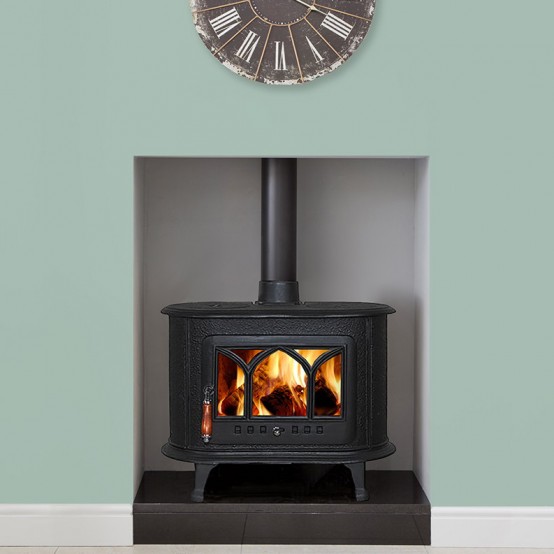
1.
Reduce
your carbon footprint
Around
20% of the UK’s greenhouse emissions are
a result of domestic heating. Burning seasoned wood however is
considered carbon neutral; this is because the carbon dioxide
produced from burning wood is equal to that of the carbon dioxide
absorbed by the tree during its lifetime.
Rotten wood can also produce carbon dioxide. Re-using and burning wood from offcuts and unused timber is also a good way to reduce the amount of wood that is sent to landfill.
2. Stoves offer impressive heat output
When compared to an equivalent gas or electric fire, solid fuel stoves will produce more heat per kilowatt/hour. The cast iron body of the stove will also provide radiant heat long after the wood has burnt away.
Can a wood burning stove heat the whole house?
A suitably sized solid fuel stove is sufficient to warm a large sized room in a short space of time. Even the largest gas stove will struggle to match the heat output and intensity of a mid-sized solid fuel stove. Although wood burning stoves can now be “linked up” to your home’s central heating and water, independent wood burning stoves are ideal for warming up certain areas of the home without needing to turn on the entire central heating system.
Factors such as the age of the property, insulation and room layout will have a bearing on the size of stove you require.
Can a wood burning stove heat water?
Some wood burning stoves can be linked up to the central heating system and domestic hot water. Besides designated “boiler stoves”, regular solid fuel stoves can be adapted to connect to boilers and underfloor heating systems, providing a logical alternative to fossil fuels. The boiler system can still work with regular fossil fuels when required.
3. Less reliance on energy providers
Having an alternative source of independent heating which does not run on fossil fuels means less reliance on energy providers. Wood burning stoves are more than 50% cheaper to run than gas, oil or electric stoves (see “Low running costs” below) whilst also reducing our carbon footprint.
Although we may not ever be totally independent of gas, electric or oil we can make small changes in how we consume energy on a daily basis.
4. Low running costs
How much do wood burning stoves cost?
In recent years the rise in demand for solid fuel stoves has kept prices competitive as more manufacturers add solid fuel stoves to their product lines. Purchase and installation costs for wood burning stoves are comparable to gas stoves.
How cost efficient are solid fuel fires?
The enclosed design of a wood burning stove means there is little or no heat loss or down draught from the chimney. Similarly the cast iron body of the stove radiates heat long after the fire has burnt out.
Solid fuel stoves offer efficiency ratings upwards of 80% in comparison to the 25-50% efficiency offered with an open-fronted alternative. Wood burning stoves reach high temperatures relatively quickly and can maintain temperature with very little fuel.
5. Reliability
In the unfortunate event of a power failure, having a wood burning stove can mean you have a sufficient source of independent heating. This is also important for homes that rely on delivery of oil or LPG fuel; bad weather can result in delays so having a solid fuel alternative is an absolute must have.
How are wood burning stoves better than other types of fires?
Solid fuels stoves require little or no maintenance other than regular cleaning. Gas stoves require a yearly service and feature safety valves, ceramic fuel beds and other components which will wear and need replacing over time.
6. Stoves are suitable for smokeless zones
Some solid fuel stoves burn authorised smokeless fuels and can be installed in areas where this is a requirement. A full list of smokeless fuels and further guidance on approved stoves be found on the DEFRA (Department for Environment, Food and Rural Affairs) website.
How to light a wood burning stove
Once your stove is ready for action you will first need to create a fire-bed using firelighters (or paper) and dry kindling wood (small pieces of dry wood which catch fire easily). The aim is to first create heat within the stove to warm the flue above. Once the firelighters have been ignited, leave the door slightly ajar to help with the pull up the flue, and to help with combustion. Once the dry kindling has began to burn intensely, you can now begin to add smaller pieces of split wood and close the stove door – if you are foraging for wood or using large logs, a log splitter is an essential tool to invest in. Avoid adding large pieces of wood at this stage; instead, gradually build up the fuel bed of the fire with smaller pieces first. Larger logs can be added once the fire has been established and is burning more intensely.
7. Attractive appearance
Finally, it has to be said that wood burning stoves can add a great deal of character to a home, and many people think they look more attractive than other types of fires.
Once you have your wood burner installed, your next decision might be how to best set it off. After all, we are talking about what is usually regarded as the focal point of your living space. A fireplace surround with mantel is the most popular option, and you will most likely want to place either a picture, a mirror or a flatscreen TV on the wall above it.
However you choose to enhance your fireplace, you can be sure that a wood burning stove will add a touch of class and rustic charm to your living room.
